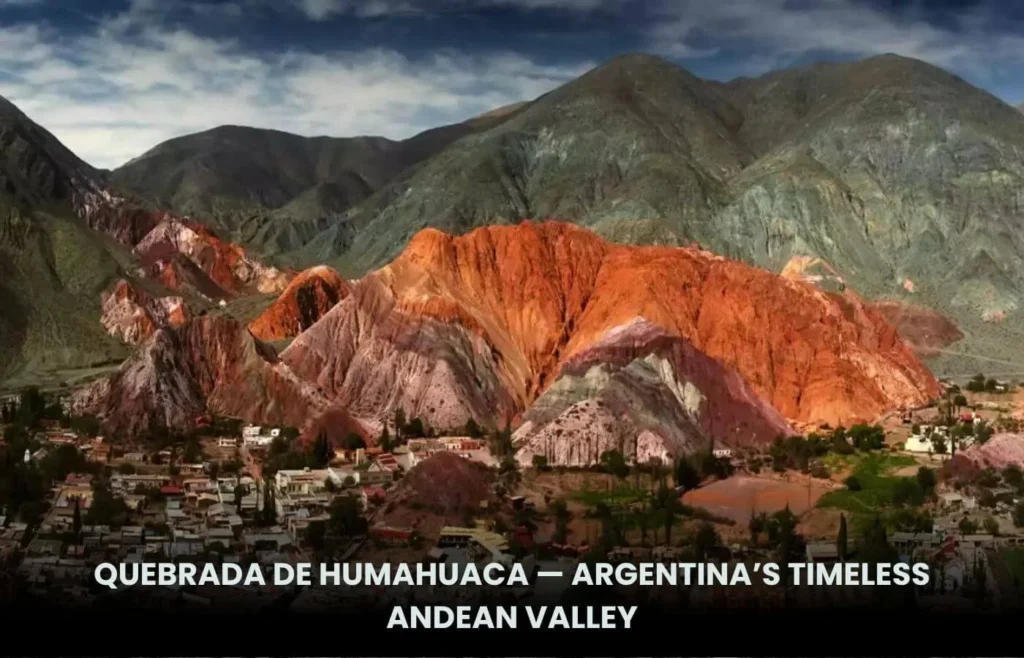
Introduction
Imagine a valley where the mountains wear stripes of vermilion, ochre, and violet — as if painted by the hands of ancient gods. A place where time folds upon itself, blending prehistoric settlements, Incan trails, and vibrant indigenous traditions with the haunting beauty of the Andean landscape. Welcome to the Quebrada de Humahuaca, Argentina’s undiscovered kaleidoscope, tucked away in the isolated northwest, far from the snow-capped peaks of Patagonia or the busy boulevards of Buenos Aires.
Located in the province of Jujuy, this narrow mountain valley stretches approximately 155 kilometers along the Río Grande and is framed by towering, color-soaked cliffs that seem to shift hues with the passing sun. But beyond its surreal geological beauty lies a deeper story — one etched across millennia of human history.
Quebrada de Humahuaca was officially recognized as a UNESCO World Heritage Site in 2003, not merely for its natural splendor but for its unbroken cultural continuity spanning over 10,000 years. From pre-Columbian hunter-gatherers to the Incan Empire, from colonial outposts to modern Andean communities, this valley has served as a living corridor of civilizations. It formed a key segment of the Qhapaq Ñan, the Inca Empire’s vast road system that connected the Andean highlands from Ecuador to Argentina — a feat of indigenous engineering and integration still studied today.
In an era where global travel is often dominated by over-commercialized destinations, Quebrada de Humahuaca offers something rare: authenticity. It is a landscape untouched by mass tourism, where ancient traditions still govern daily life, and where every rock and ritual tells a story. As travelers increasingly seek meaningful, lesser-known heritage destinations that foster connection and cultural respect, the Quebrada is emerging as a beacon for conscious exploration.
In this article, we journey through the heart of this valley — unraveling its geological wonders, ancestral heritage, vibrant communities, and timeless charm. Whether you’re a history enthusiast, cultural traveler, or nature lover, Quebrada de Humahuaca promises an experience as enriching as it is unforgettable.
Geography and Geology
Tucked away in the rugged expanses of Jujuy Province, the Quebrada de Humahuaca carves a spectacular route through Argentina’s northwestern Andes. Running from south to north, this high-altitude valley traces the Río Grande for over 150 kilometers, beginning near the town of Volcán and stretching all the way to the Bolivian border. Perched at elevations ranging between 2,000 and 3,000 meters above sea level, the region is cradled by stark, angular mountains that rise like ancient sentinels — guardians of a land that has borne witness to thousands of years of cultural evolution.
A Geological Time Capsule
The Quebrada is not just a passage through space — it’s a journey through geological time. The valley walls and surrounding cliffs are composed of sedimentary rock formations that date back more than 600 million years, offering a rare window into Earth’s deep past. Layer upon layer of sandstone, limestone, and claystone reveal a complex history of tectonic shifts, volcanic activity, and erosion, each contributing to the surreal palette of colors that define the landscape today.
These stratified formations are not merely beautiful — they are scientifically invaluable. Paleontologists and geologists have long studied the Quebrada’s exposed cross-sections to understand the sequence of climatic and biological events that shaped the Andean region. Fossilized flora and fauna embedded in the rock layers provide further insight into the evolution of life on this continent.
The Iconic Hill of Seven Colors
The Cerro de los Siete Colores, often known as the Hill of Seven Colors, is one of the valley’s most fascinating natural wonders. It is situated in the little community of Purmamarca. This natural phenomenon appears as if painted by a divine brush: streaks of red, pink, green, yellow, white, and even lavender wrap the hillside in a mesmerizing spectrum. The colors are the result of oxidized minerals and sediment layers from various geological epochs, compressed and exposed over time.
- Red tones stem from iron-rich clay.
- Green hues come from chlorite.
- Pale yellows and whites are attributed to calcium carbonates.
- Lavenders and purples arise from magnesium-bearing rocks.
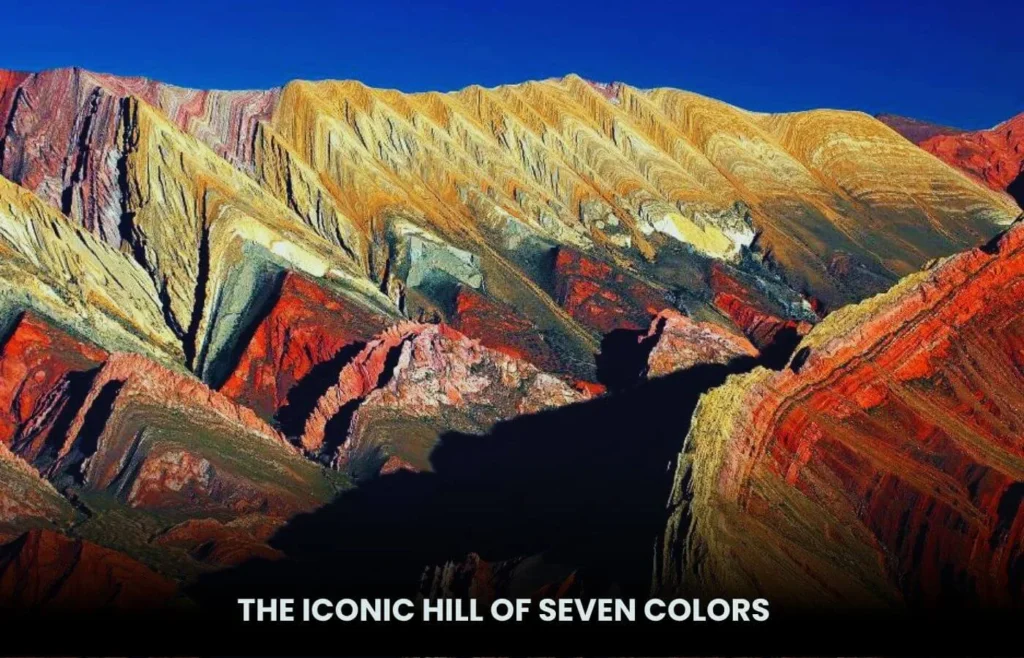
This polychromatic spectacle shifts with the sunlight throughout the day, creating a dynamic visual experience that photographers and nature lovers treasure. The Hill of Seven Colors is not merely an Instagrammable site — it’s a living geological archive, a symbol of the Earth’s restless creativity.
More than Just a Scenic Valley
While the Cerro garners the spotlight, the entire Quebrada is a canvas of multicolored stratifications. The landscape features other equally stunning sites such as the Paleta del Pintor (Painter’s Palette) near Maimará, where an array of colors cascade down like spilled pigments. Farther north, the mountains of Hornocal, sometimes referred to as the Serranía de los Catorce Colores (Fourteen-Colored Mountain Range), dazzle with zigzagging chromatic bands — another geological masterpiece forged over eons.
These formations aren’t just static backdrops — they shape the way people live, build, farm, and celebrate. Local communities have historically harmonized their lifestyles with the rhythms of the land, adapting to its high altitude, arid climate, and resource availability.
The geography and geology of Quebrada de Humahuaca are more than impressive — they’re integral to understanding how Earth’s natural forces and human civilization have intertwined across time. The landscape is not just a feast for the eyes; it’s a cradle of knowledge, spirituality, and heritage.
Historical and Cultural Significance
To walk through the Quebrada de Humahuaca is to walk through 10,000 years of uninterrupted human history — a rare continuity that gives the valley its soul and cultural prestige. It is not just a place of stunning geological features, but a living heritage corridor, where each layer of civilization, from prehistoric nomads to colonial missionaries, has left its indelible mark on the land.
Ancient Roots: A Cradle of Civilizations
Archaeological evidence places human settlement in the Quebrada as far back as 10,000 years ago, making it one of the oldest continuously inhabited regions in the Americas. The valley’s strategic location — nestled between fertile highland plateaus and lowland ecosystems — allowed early hunter-gatherer communities to thrive here.
As time progressed, these communities evolved into increasingly complex agrarian societies, with advanced irrigation systems, crop rotation techniques, and trade networks. Sites like Pucará de Tilcara, a pre-Inca fortified town, reveal the architectural sophistication and strategic prowess of the Omaguaca people, one of the valley’s principal pre-Hispanic cultures.
These early settlers weren’t isolated. The Quebrada functioned as a natural north-south corridor, facilitating cultural exchange, migration, and commerce between the Andean highlands and the plains of modern-day Argentina. This interconnectivity laid the groundwork for the region’s future role in a much larger imperial network.
The Inca Connection: A Vital Artery of the Qhapaq Ñan
By the 15th century, the Quebrada de Humahuaca had been absorbed into the Inca Empire, the largest empire in pre-Columbian America. The valley became a critical node in the Qhapaq Ñan, or Royal Road, a vast system of highways that spanned over 30,000 kilometers across the Andean world — from Quito in Ecuador to Santiago in Chile.
The Qhapaq Ñan was more than a road. It was the Inca Empire’s lifeline, enabling the movement of armies, messengers, goods, and knowledge across immense distances. Along this route, the Quebrada was strategically vital, serving as both a military outpost and a trade conduit. Traces of Incan infrastructure — tambos (way stations), agricultural terraces, and stone-paved trails — still dot the landscape today, preserved by time and tradition.
In 2014, UNESCO extended the World Heritage status of the Qhapaq Ñan to include the Quebrada de Humahuaca as part of this vast cultural network, further validating the region’s enduring significance on a continental scale.
Colonial Legacy: The Spanish Footprint and Catholic Missions
The 16th century brought a dramatic cultural transformation with the arrival of Spanish conquistadors. The valley’s existing infrastructure and strategic position once again played a central role — this time as part of the Camino Real, the colonial trade route that linked Upper Peru (modern Bolivia) with Buenos Aires. The Quebrada became a key supply chain for silver transport, especially from the rich mines of Potosí.
With colonization came religious missions, many of which were established to convert local populations to Christianity. Small towns like Uquía, Tilcara, and Humahuaca are home to colonial-era churches, some dating back to the 17th century. These churches — often simple on the outside but rich with baroque altarpieces and Cuzco School paintings — reflect the merging of Spanish religious influence with indigenous artistic expression.
One particularly notable structure is the Iglesia de San Francisco de Paula in Uquía, where angelic figures are depicted wielding muskets — a distinctly Andean reinterpretation of Catholic iconography, symbolizing the fusion of two worlds. Festivals such as Semana Santa and Carnaval blend Christian rituals with indigenous elements, showcasing how deeply syncretism runs through the cultural veins of the Quebrada.
A Living Heritage
Despite centuries of change — imperial conquest, colonization, modernization — the cultural traditions of the Quebrada have not only survived but flourished. Many residents today are direct descendants of the Omaguaca, Quechua, and Aymara peoples, keeping alive ancestral languages, agricultural customs, and spiritual practices.
From traditional music played on quenas and charangos, to the vibrant textiles woven with patterns passed down through generations, the valley remains a repository of cultural continuity. More than just a scenic destination, Quebrada de Humahuaca stands as a vibrant chronicle of South America’s enduring soul — where layers of indigenous heritage and colonial history unfold across a majestic Andean landscape.
“Quebrada de Humahuaca exemplifies the concept of cultural landscape — where natural beauty and human heritage are inseparable. Its value is not just historical; it is ongoing, lived, and deeply local.”
– Dr. María Eugenia Báez, a cultural anthropologist at the Universidad Nacional de Jujuy
Indigenous Communities and Living Traditions
Though the Quebrada de Humahuaca’s geological formations are awe-inspiring, it is the cultural vitality of its communities that gives the region its enduring significance. In this timeless Andean corridor, heritage is not a relic — it is alive, practiced, celebrated, and passed on with pride by communities that trace their ancestry to some of South America’s oldest civilizations.
Ethnic Identity: Keepers of Ancient Lineages
The valley is home to descendants of Quechua, Aymara, and Omaguaca peoples, each contributing to a mosaic of cultures that have endured colonialism, marginalization, and globalization. Unlike many indigenous communities that have lost direct ties to their roots, the people of the Quebrada have preserved their ethnic identity through continued connection to the land, community-based practices, and oral traditions.
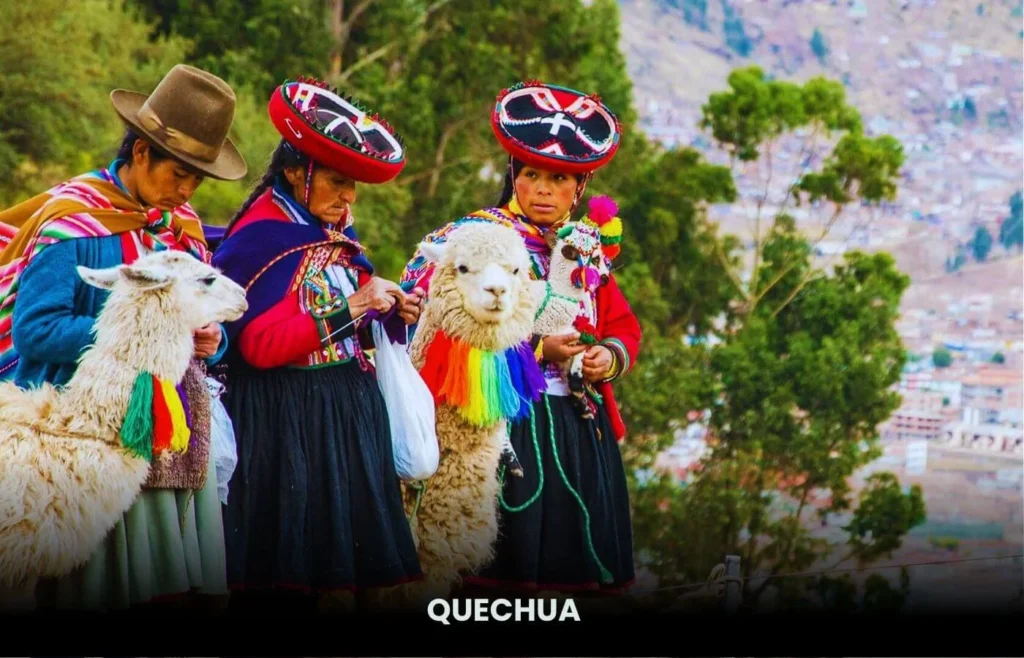
- The Omaguaca, native to this specific valley, were known for their fortified settlements, strategic warfare, and agriculture.
- The Quechua, who came with the expansion of the Inca Empire, brought their language, metallurgy, and spiritual cosmology.
- The Aymara, originally from the Altiplano region of Bolivia, also left cultural imprints through textiles, musical instruments, and communal customs.
This ethnic fusion, born of centuries of coexistence and resilience, shapes everything from architecture and cuisine to dress and worldview.
Rituals and Languages: The Andes’ Syncretic Heartbeat
Language in the Quebrada is more than a means of communication — it is a vessel of cosmic understanding and cultural resistance. While Spanish is widely spoken, Quechua and Aymara phrases are commonly heard in homes, markets, and rituals, especially among elders and traditional healers. Efforts are underway by regional schools and cultural associations to revive indigenous languages, ensuring that linguistic heritage is not lost to time.
Religious practices in the region represent a deep syncretism — a harmonious blend of pre-Hispanic spirituality and Catholic beliefs. The worship of Pachamama, or Mother Earth, who is regarded as the highest deity in Andean mythology, is one of the holiest customs. Each August, families across the Quebrada dig a symbolic hole called a corpachada, into which they offer coca leaves, chicha (fermented corn drink), alcohol, food, and even cigarettes — gifts to Pachamama in exchange for health, fertility, and protection.
At the same time, Catholic saints are honored with processions, Masses, and communal feasts. It’s not uncommon to see Andean priests and Catholic clergy collaborating, especially during shared festivals where ritual elements from both traditions coexist seamlessly — a phenomenon UNESCO recognizes as intangible cultural heritage in many Andean regions.
Festivals: Where Tradition Comes Alive
Festivals in the Quebrada are more than spectacles; they are living expressions of cultural memory, resistance, and joy.
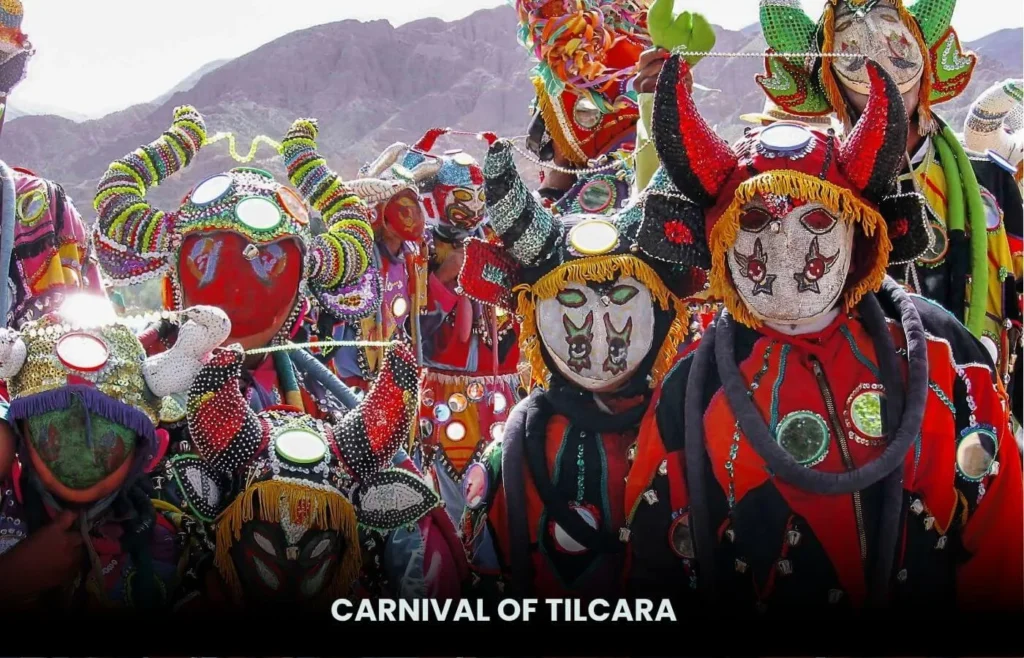
- Carnival of Tilcara: Perhaps the most famous is the Carnaval de Tilcara, celebrated in February or early March. Unlike its urban counterparts, this carnival is deeply rooted in indigenous tradition. The festival begins with the unearthing of the devil (el diablo), a symbolic figure of chaos and release. Participants wear devil masks and vibrant costumes, dancing through the streets to the sounds of traditional brass bands and charangos (small stringed instruments). The week-long celebration is a whirlwind of dance, satire, food, and drink, culminating with the reburial of the devil, symbolizing the return of order and the beginning of a new cycle.
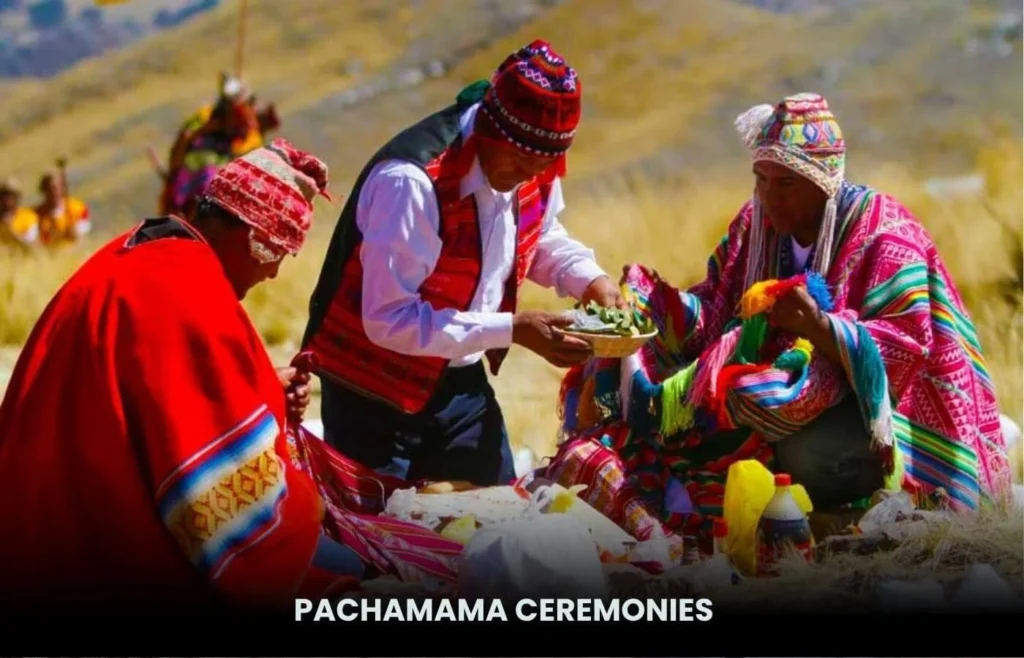
- Pachamama Ceremonies (August): In August, the entire region slows down to honor Pachamama. Families, farms, and villages engage in ritual offerings, communal gatherings, and music. Unlike more commercialized festivals, these ceremonies are intimate, familial, and deeply spiritual — often passed down through generations without alteration.
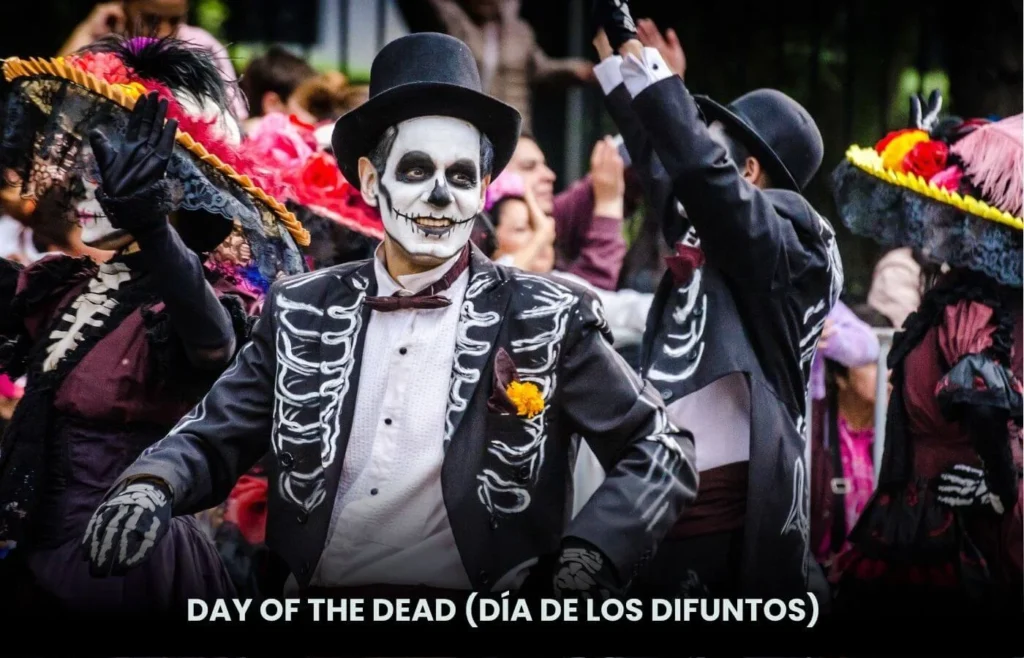
- Day of the Dead (Día de los Difuntos): Celebrated on November 1st and 2nd, this observance blends Catholic All Saints’ Day with ancestral remembrance. Homes are decorated with mini altars, favorite foods of deceased relatives, and Andean icons, reflecting the belief that the dead return for one night to visit their families.
Traditional Music and Dance: Storytelling Through Sound and Movement
Music is another pillar of indigenous identity in the Quebrada. The quena (a bamboo flute), siku (panpipes), and bombo legüero (a deep drum) are among the instruments used to accompany folk songs about spiritual longing, heartbreak, migration, and harvests. Many tunes are sung in Quechua or Aymara, particularly during festivals and community gatherings.
Dances like the carnavalito, bailecito, and coplas (a type of improvised singing) are performed in colorful, hand-woven garments — each pattern and color telling a story of tribal affiliation, land, and ancestry. These dances are not staged performances; they are communal rites, designed to reinforce bonds and transmit identity through generations.
Preserving the Living Heritage
Organizations like INTI (Instituto Nacional de Tecnología Industrial) and local cultural cooperatives work with indigenous artisans to preserve traditional knowledge, improve sustainable livelihoods, and document oral histories. Tourism initiatives now increasingly favor cultural immersion over mere sightseeing, encouraging visitors to engage with local families, partake in workshops, and respectfully witness ceremonies.
These efforts affirm that the Quebrada de Humahuaca is not just a UNESCO World Heritage Site because of its past — but because its living traditions continue to enrich global heritage in the present.
“The Quebrada is a vibrant echo of pre-Columbian voices. It is not merely a site of ancient history but a guardian of cultures that never died.”
– Dr. Ana María Portal, an ethnomusicologist from the Universidad de Buenos Aires
Top Places to Visit in Quebrada de Humahuaca
The Quebrada de Humahuaca is more than a passage through Argentina’s northwest — it is a living canvas of color, history, and culture. Each town and village along the valley offers a distinct perspective into the region’s multifaceted identity. From geological wonders to colonial heritage and pre-Hispanic ruins, here are four must-visit destinations that capture the spirit of the Quebrada.
Purmamarca: Gateway to the Cerro de los Siete Colores
Nestled at the base of the Cerro de los Siete Colores (Hill of Seven Colors), Purmamarca is often the first stop for travelers exploring the Quebrada — and for good reason. This postcard-perfect village is the heart of the valley’s natural splendor, with adobe houses, cobbled streets, and a laid-back rhythm that invites you to slow down and take in the landscape.
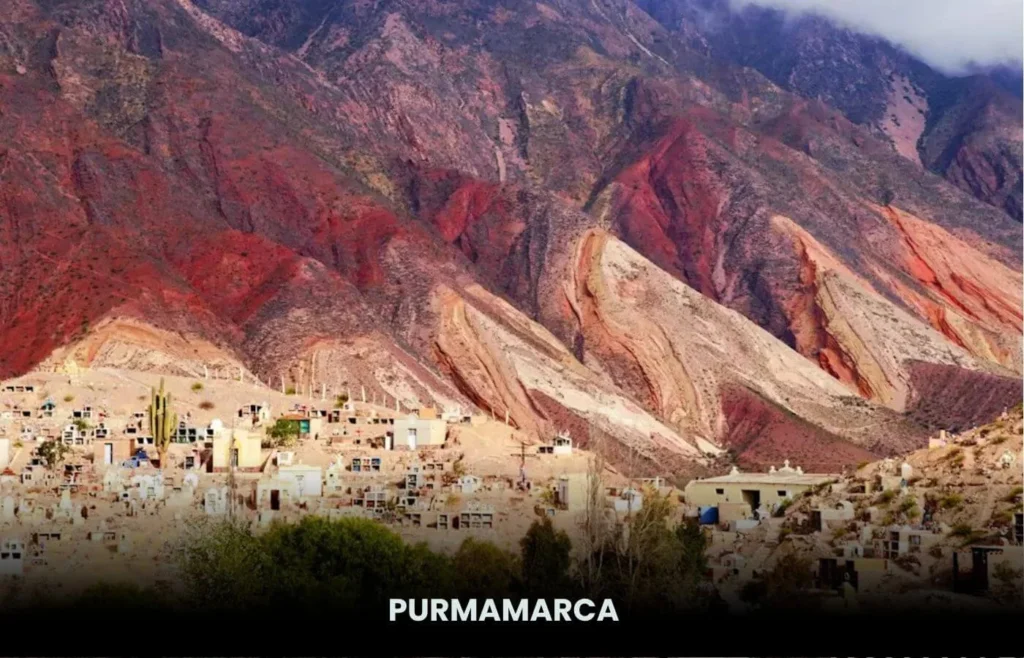
The main attraction is, of course, the Hill of Seven Colors — a geological masterpiece where sedimentary layers painted in vibrant reds, greens, yellows, and purples rise behind the village like a surreal backdrop. Best viewed at sunrise, the hill’s colors glow dramatically in the morning light, making it a favorite for photographers and nature lovers alike.
Don’t Miss:
- Paseo de los Colorados: A 3-kilometer loop trail offering panoramic views of the hill and surrounding valleys.
- Iglesia de Santa Rosa de Lima: A 17th-century adobe church, recognized as a National Historic Monument.
- Purmamarca Artisan Market: Located around the town square, offering handmade textiles, ceramics, and alpaca wool products from local artisans.
Insider Tip: Visit midweek to avoid crowds and enjoy quiet moments with the villagers, many of whom still speak Quechua and follow traditional farming practices.
Tilcara: Where Archaeology Meets Art
Often referred to as the cultural capital of the Quebrada, Tilcara is a vibrant fusion of ancient heritage and contemporary creativity. This town is best known for the Pucará de Tilcara, a pre-Incan fortress built by the Omaguaca people over 900 years ago. Perched on a hill overlooking the Río Grande, the ruins offer sweeping views and insights into ancient Andean defensive architecture.
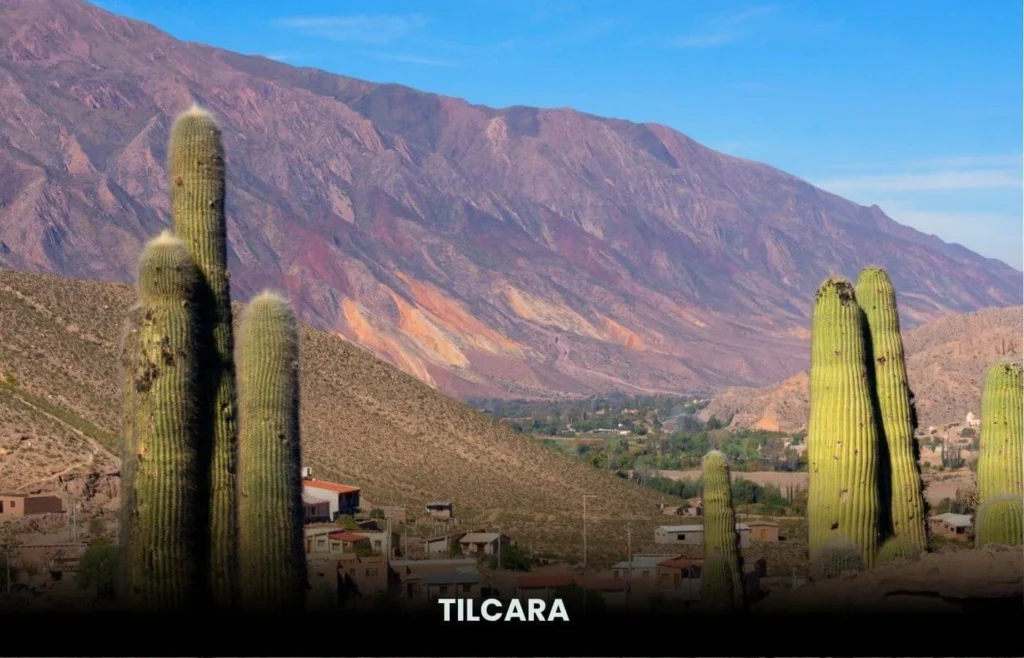
Tilcara is also a hub for artists, musicians, and anthropologists, who are drawn to its bohemian energy and deep historical roots. Museums, galleries, and music venues dot the town, making it an ideal base for travelers who want to immerse themselves in both the past and present of the region.
Don’t Miss:
- Pucará de Tilcara: Restored archaeological site with reconstructed dwellings and a botanical garden of native cacti.
- Thousands of items from the pre-Hispanic cultures of the Quebrada can be found at the Dr. Eduardo Casanova Museum of Archaeology.
- Tilcara Carnival: A joyful fusion of indigenous and Catholic traditions featuring music, satire, and costumed parades.
“Tilcara offers one of the most complete experiences for understanding the Quebrada’s layered history — from stone-age tools to colonial manuscripts.”
– Dr. Federico Téllez, an archaeologist from the Universidad Nacional de Jujuy
Humahuaca: History Etched in Stone and Spirit
At the northern end of the valley lies Humahuaca, a historic town that lends its name to the entire region. Once a major outpost along the Inca and Spanish trade routes, Humahuaca boasts a well-preserved colonial core that feels like stepping back in time.
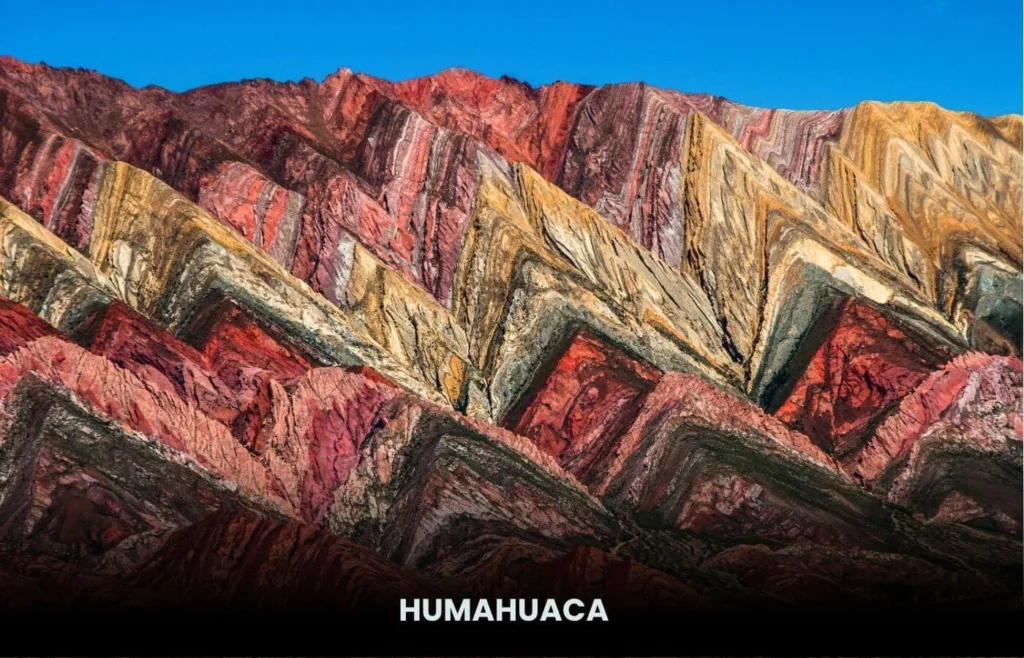
Its narrow streets, whitewashed buildings, and rustic charm are complemented by a strong sense of cultural identity. The combination of colonial architecture and indigenous pride here is evidence of the Andean spirit’s tenacity.
The Monumento a los Héroes de la Independencia, a soaring bronze statue atop a majestic staircase, is the town’s focal point and honors the guerilla warriors who protected the area during Argentina’s early 19th-century independence struggles.
Don’t Miss:
- Cabildo and Clock Tower: Every day at noon, a mechanical saint appears to bless the crowd below — a popular tradition among visitors.
- Calle Salta Market: Local food stalls offering humitas, tamales, and empanadas made with Andean ingredients.
- Annual Fiesta de la Virgen de la Candelaria (February): Blends Catholic processionals with indigenous dances and costumes.
Travel Tip:
Stay overnight to experience the vibrant night markets and traditional music sessions, often held in peñas (folk music taverns) around town.
Uquía: Home of the Warrior Angels
Just a short drive from Humahuaca lies Uquía, a small yet culturally rich village that harbors one of the region’s most unexpected artistic treasures: the Iglesia de San Francisco de Paula. This modest 17th-century church houses a rare collection of Cuzco School paintings, most notably the series of “Ángeles Arcabuceros” — angels wielding muskets, dressed as Spanish aristocrats.
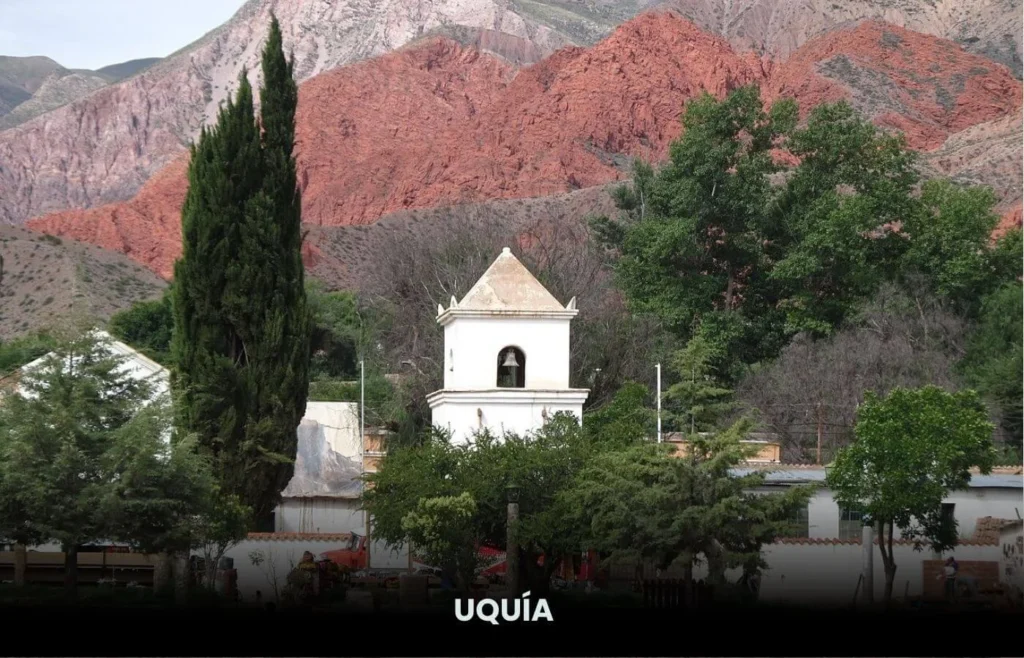
These paintings are a stunning example of Andean-Baroque art, created by indigenous artists under colonial rule. The images reflect not just religious devotion, but also the fusion — and tension — between imposed Spanish Christianity and native worldviews.
Don’t Miss:
- Painted Church Interior: Original wooden altarpiece and frescoes.
- Quebrada del Río Las Señoritas: A nearby red-rock canyon ideal for short hikes and photography.
- Local Weaving Cooperatives: Women-led groups keeping traditional textile techniques alive.
Cultural Note: Locals consider the church and its paintings a spiritual site, not just a tourist attraction. Visitors are encouraged to enter respectfully and refrain from flash photography.
Every location along the Quebrada de Humahuaca, from the warrior angels of Uquía to the rainbow hills of Purmamarca, presents a unique aspect of this UNESCO-listed gem. More than just scenic beauty, these towns preserve a living, breathing heritage — where ancient traditions are honored, modern creativity flourishes, and the past is never truly past.
Whether you’re tracing ancient roads, attending a Pachamama ritual, or simply enjoying a home-cooked Andean meal, the Quebrada invites you to be more than a tourist — it welcomes you as a participant in a story that’s still being written.
Flora, Fauna, and Natural Beauty
The Quebrada de Humahuaca, which is tucked away between towering Andean peaks, is a biodiversity hotspot and cultural corridor where high-altitude grasslands, riverine ecosystems, and desert landscapes come together to form a breathtaking natural mosaic. Its varied microclimates and elevations — ranging from 2,000 to over 4,000 meters above sea level — support an impressive array of flora and fauna that have adapted to extreme conditions over millennia.
Desert Meets Highlands: Resilient Flora of the Quebrada
The vegetation in Quebrada de Humahuaca reflects its semi-arid, highland environment. Much of the environment is dominated by the famous cardón cactus (Echinopsis atacamensis), which has a tall shape and grows slowly. These ancient plants, some of which can live up to 300 years, not only store water in their spongy tissues but also serve as homes for birds and insects.
In lower elevations and along riverbeds, tough desert shrubs such as jarillas and chillka thrive, while mountain herbs like muña-muña and coca have been utilized for centuries in indigenous medicine for their healing properties and adaptability to thin, oxygen-poor air. The flora of the region is not just visually striking — it’s deeply interwoven with local tradition and survival, forming a natural pharmacy and food source for Andean communities.
Unique Ecosystems: Rivers, Valleys, and Altiplano Plateaus
What makes the Quebrada ecologically distinctive is the juxtaposition of ecosystems within a relatively narrow corridor. The Río Grande snakes its way through the valley floor, giving life to riparian vegetation and enabling agriculture in otherwise dry surroundings. Small patches of cultivated land with maize, quinoa, and potatoes emerge like green oases against a background of red and ochre hills.
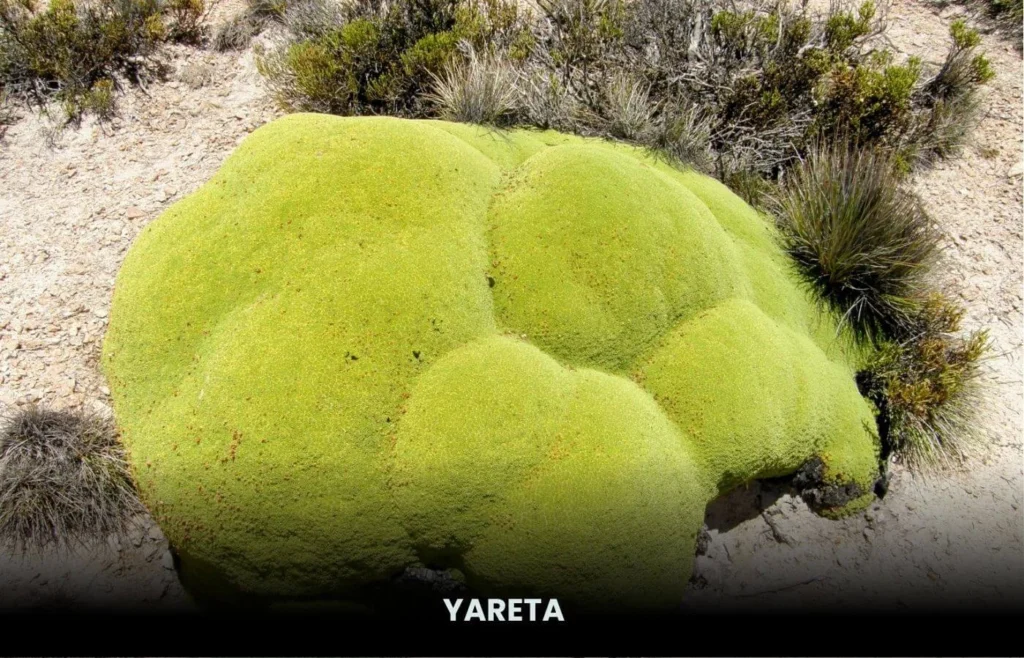
As you ascend toward the Altiplano (high plateau), vegetation becomes scarcer but more specialized. Yareta, a dense, slow-growing moss-like plant, carpets rocks and acts as insulation against the freezing night temperatures. These plateaus are crucial for seasonal migrations and grazing grounds for camelids like llamas and vicuñas.
The Faunal Treasures: Wildlife of the High Andes
The Quebrada’s rugged terrain supports a surprising variety of wildlife, much of it emblematic of the Andean region. Vicuñas, wild ancestors of domesticated alpacas, roam the higher plains in small herds, their fine wool prized for its softness and rarity. These graceful creatures are protected under national conservation programs due to their vulnerability to poaching.
Above the cliffs and peaks, Andean condors glide effortlessly on thermal currents. These majestic scavengers, among the largest flying birds in the world, are more than biological wonders — they hold spiritual significance for local indigenous beliefs, symbolizing death, rebirth, and the connection between earth and sky.
Birdlife, too, flourishes in the quebrada. Hummingbirds, finches, and the striking Andean flicker bring life and color to even the driest stretches. Llamas, often seen grazing near villages or trekking with their herders, are not only domesticated pack animals but an enduring symbol of Andean heritage.
Conservation and Ecological Stewardship
Despite its ruggedness, the Quebrada de Humahuaca remains a fragile ecosystem, increasingly vulnerable to climate change, tourism, and unregulated development. Rising temperatures, altered rainfall patterns, and soil erosion pose real threats to native plant and animal species. Fortunately, regional conservation efforts, including protected zones and sustainable tourism initiatives, are aiming to safeguard this irreplaceable natural legacy.
Local communities, drawing on centuries of ecological wisdom, are also playing a pivotal role. From preserving heirloom crops to regulating grazing and promoting eco-tourism, they remain guardians of the Quebrada’s natural integrity.
A Living Landscape
More than just a scenic destination, Quebrada de Humahuaca is a living, breathing landscape, where ecological resilience, ancestral knowledge, and stunning natural beauty converge. Whether you’re observing a vicuña at sunrise, wandering through fields of giant cacti, or hearing the call of a condor overhead, the region offers a profound reminder of the interconnectedness between nature, culture, and time.
How to Experience Quebrada Authentically
Exploring the Quebrada de Humahuaca is not just about sightseeing—it’s about immersing yourself in a cultural, historical, and natural narrative that spans millennia. To truly understand this UNESCO World Heritage valley, one must go beyond the postcard views and connect with its people, traditions, and terrain. Here are some tips for having an authentic Quebrada de Humahuaca experience.
Cultural Tourism: Live Like a Local
The heart of Quebrada beats through its people. Many Quechua and Aymara families open their doors to visitors, offering homestay experiences that provide an intimate glimpse into daily Andean life. These visits provide profound human connection in addition to lodging. Guests may participate in age-old practices like weaving, farming, or preparing traditional meals, often handed down through generations.
Artisan markets, especially in towns like Tilcara and Purmamarca, are vibrant hubs of creativity and identity. Here, travelers can purchase handcrafted textiles, ceramics, and musical instruments directly from local craftspeople, ensuring fair trade and cultural continuity. Engaging in guided cultural tours led by indigenous guides also ensures a respectful and informative experience, with stories told from a local perspective—rich in nuance, symbolism, and pride.
Gastronomy: A Taste of the Andes
Andean cuisine in the Quebrada is as rooted in the land as the ancient civilizations that once thrived here. The high-altitude terrain lends itself to hearty, nutrient-rich ingredients that are the foundation of local dishes.
- Quinoa, once revered as the “mother grain” by the Incas, is a staple served in stews, soups, or as a side to meat dishes.
- Tamales, made from ground corn and wrapped in husks, are often flavored with local herbs or filled with meats and cheeses.
- Llama meat, lean and rich in protein, features prominently in regional dishes, either grilled, stewed, or dried into jerky (charqui).
- Corn, in its many varieties and colors, forms the basis of comforting dishes like humita and locro, slow-cooked meals that tell a story of heritage and survival.
Eating at family-run eateries or local markets is a culinary adventure that connects you directly to the land and its people, far removed from the mass-produced tourist fare.
Adventure Activities: Explore the Land’s Soul
Exploration is encouraged by the Quebrada de Humahuaca’s spectacular geography. With altitudes ranging from 2,000 to over 3,000 meters, the landscape offers adrenaline-pumping activities with a cultural backdrop.
- Trekking routes, such as those leading to the ancient Pucará de Tilcara fortress or hidden cave paintings, combine physical challenge with historical exploration.
- Horseback riding, a traditional Andean mode of transport, allows for a slow, rhythmic journey through valleys and mountain passes, often guided by local gauchos.
- Cycling tours through the Quebrada’s varied terrain—from the painted hills of Purmamarca to the colonial charm of Humahuaca town—offer a sense of freedom and intimacy with the surroundings.
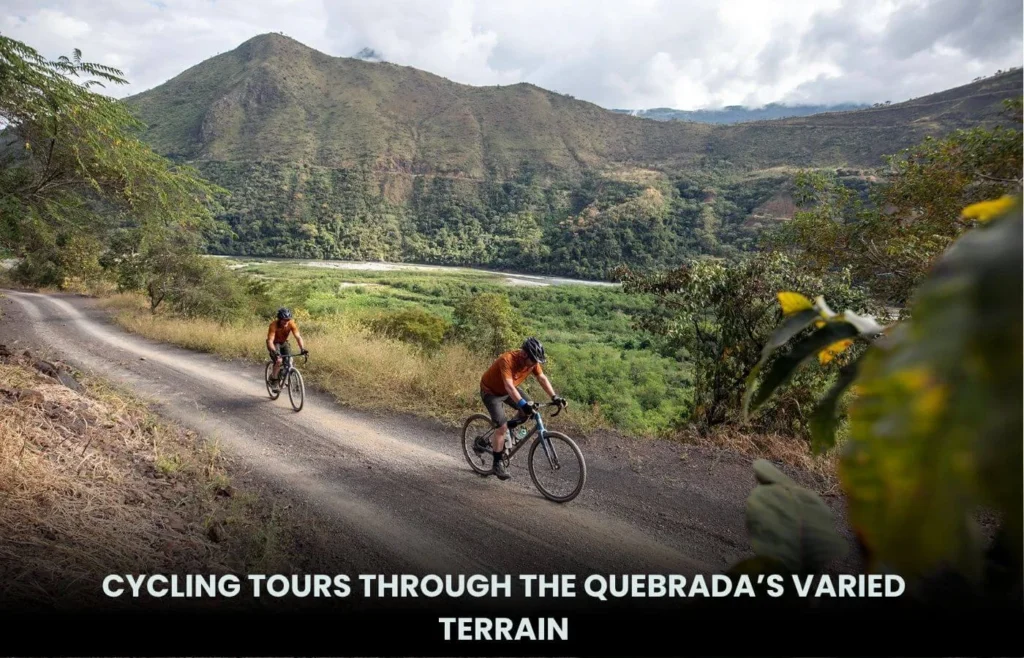
All these experiences promote sustainable tourism, encouraging visitors to interact respectfully with both the environment and the communities who call this land home.
Embrace the Spirit of the Quebrada
Authenticity in the Quebrada de Humahuaca isn’t something you find—it’s something you feel. It’s in the warm hospitality of a host family, the rhythmic beats of a traditional festival, the aroma of food cooked over an open flame, and the silence of high mountain paths. When you travel with humility and curiosity, the Quebrada reveals its soul.
By choosing immersive, respectful, and locally-rooted experiences, travelers not only enrich their own journey but contribute to the preservation and celebration of this extraordinary cultural landscape.
UNESCO World Heritage Status
Preserving the Living Legacy of Quebrada de Humahuaca
In 2003, UNESCO honored the Quebrada de Humahuaca with World Heritage status, acknowledging not just its breathtaking landscapes but also its profound historical and cultural roots. This recognition has placed the valley among the world’s most treasured cultural corridors, cementing its status as a site of global significance.
Why Quebrada de Humahuaca Earned UNESCO Status
When the Quebrada gained UNESCO World Heritage status, it did so based on Cultural Criteria (ii), (iv), and (v), highlighting its role as a living testimony of human history.
- Cultural Continuity Over 10,000 Years: The valley served as a key passage for migratory populations, traders, and armies, preserving human occupation since prehistoric times. It was part of the Inca Empire’s vast road network and later a major route during Spanish colonization.
- Landscape-Human Integration: The way local communities have interacted with the land for millennia — from terraced agriculture and irrigation to religious rituals tied to natural features — exemplifies harmony between nature and culture.
- Living Traditions and Architecture: The architecture of colonial churches, pre-Hispanic ruins, and indigenous settlements reveal layers of civilization. Traditional knowledge systems, agricultural practices, and festivals remain alive in everyday life.
Preservation Through Sustainable Tourism
UNESCO recognition does more than attract global attention; it also drives preservation initiatives and community-led tourism models. Several key efforts support this:
- Community Involvement: Local residents actively participate in managing tourism services, including guiding, lodging, and cultural workshops. Their insights help maintain authenticity while creating economic opportunities.
- Infrastructure with Minimal Impact: Sustainable building practices are encouraged to ensure that modern tourism development doesn’t overshadow traditional architecture or damage fragile ecosystems.
- Environmental Conservation: Initiatives focus on protecting the region’s unique ecosystems — including high-altitude valleys and native species like the cardón cactus and the condor — while balancing visitor access to sensitive sites.
Challenges and Stewardship
With its growing popularity, Quebrada faces the challenge of balancing tourism with preservation. Mass tourism threatens the fragile cultural landscape and the pace of modernization risks diluting traditions. To counter this:
- Heritage Education programs aim to inform both tourists and locals about the importance of conserving cultural and natural heritage.
- Zoning regulations help control urban sprawl and inappropriate construction in historically sensitive areas.
- Collaborations with UNESCO and academic institutions foster research, documentation, and long-term conservation strategies.
A Living Cultural Corridor
What makes Quebrada de Humahuaca truly unique is that it’s not a static monument of the past. It’s a living, evolving cultural corridor — where ancient rituals are still performed, ancestral languages are spoken, and the spirit of Pachamama (Mother Earth) is honored in everyday acts.
UNESCO’s recognition celebrates this synthesis of history, nature, and identity — not as relics, but as vibrant components of life in northern Argentina. Travelers who walk its paths aren’t just sightseers; they are witnesses to a story that has been unfolding for over ten millennia.
Best Time to Visit & Travel Tips
Seasonal Guidance: Embrace the Dry Season Magic (May–September)
When planning your trip to the Quebrada de Humahuaca, timing can significantly enhance your experience. The dry season, which spans from May to September, is widely regarded as the most favorable period to explore the region. During these months, the skies are usually crystal clear, with abundant sunshine and minimal rainfall, offering uninterrupted views of the striking rock formations, including the iconic Cerro de los Siete Colores.
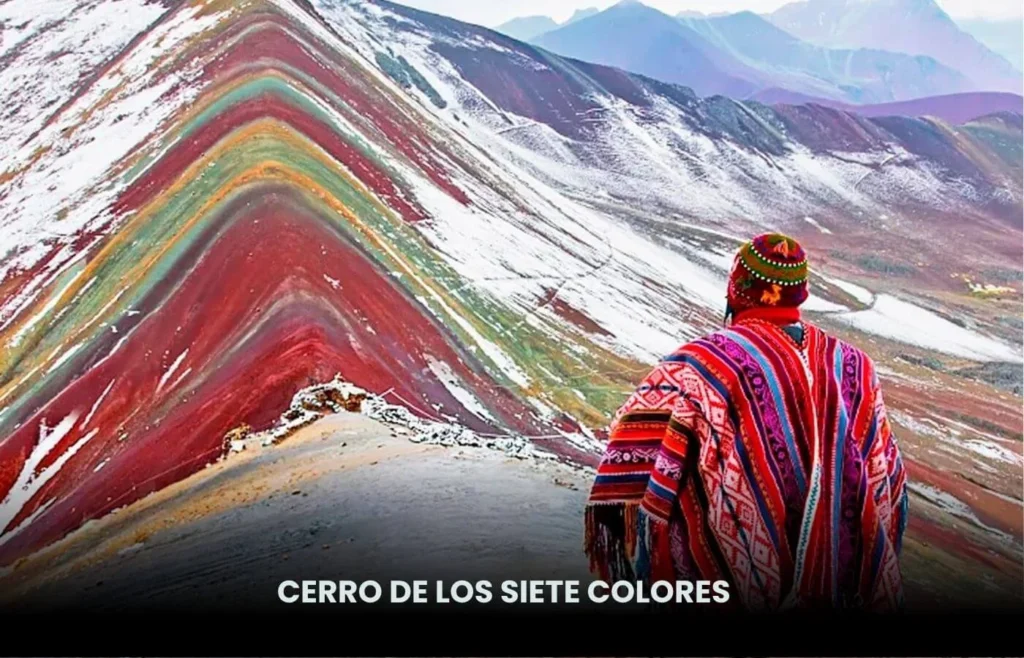
Temperatures during the day remain comfortably warm, ranging from 16°C to 25°C, while nights can drop below freezing — especially in high-altitude towns like Humahuaca. Layered clothing is essential to adapt to these variations. Winter also brings the added benefit of smaller crowds, making it ideal for travelers seeking solitude and authenticity.
On the other hand, the rainy season (December to March) transforms the landscape into a lush green valley, which might appeal to photographers and nature lovers. However, unpredictable rains can cause road disruptions, especially in remote areas, so off-season travel requires extra caution and flexibility.
Getting There: Accessing the Quebrada
Although Quebrada de Humahuaca feels like a remote Andean enclave, it is surprisingly accessible via major cities in northern Argentina:
- From Salta: The provincial capital is about 250 km south of Humahuaca. You can rent a car for a scenic road trip along Ruta Nacional 9, or opt for comfortable long-distance buses that connect Salta to Purmamarca, Tilcara, and Humahuaca.
- From San Salvador de Jujuy: Located just 120 km from the Quebrada, Jujuy is the closest major city and serves as a gateway for travelers. Daily buses and rental cars make for easy transport into the heart of the valley.
To truly appreciate the diverse geography and slow rhythms of the Quebrada, self-driving is highly recommended. The roads are generally well-maintained and safe, though narrow mountain curves require cautious driving, especially at night.
Health Tips: Prepare for High Altitude & Travel Responsibly
The Quebrada stretches between 2,000 and 3,000 meters above sea level, which can pose a challenge for those unaccustomed to high altitudes. Travelers may experience symptoms such as shortness of breath, fatigue, or mild headaches — commonly known as soroche (altitude sickness). To minimize discomfort:
- Acclimate gradually, especially if coming from lower elevations.
- Hydrate regularly, and avoid heavy meals or alcohol on your first day.
- Coca tea, a traditional remedy offered in local cafés, is known to ease symptoms.
Additionally, being a UNESCO-protected region with fragile ecosystems, the Quebrada calls for eco-conscious travel behavior. Stick to marked trails during hikes, avoid single-use plastics, and support local businesses that follow sustainable practices.
Bringing sunscreen, a reusable water bottle, sturdy hiking shoes, and a first-aid kit is essential for a safe and enjoyable journey. Mobile signals can be intermittent, so offline maps and printed itineraries are smart backup options.
Travel Tip
Visit during local festivals — such as the vibrant Carnaval de Tilcara in February — for a spectacular immersion into Andean traditions, complete with music, dance, and ceremonial rituals.
Conclusion & FAQs
Nestled in Argentina’s far northwest, Quebrada de Humahuaca isn’t just a destination — it’s a journey through time, color, culture, and untouched nature. From the rainbow-streaked mountains of Purmamarca to the colonial whispers of Humahuaca town, every bend in the valley tells a story shaped by Indigenous heritage, colonial history, and natural splendor.
Its recognition as a UNESCO World Heritage Site is not merely honorary—it is testament to the valley’s profound integration of cultural continuity and dramatic landscapes. Whether you’re tasting Andean delicacies, trekking along ancient trade routes, or simply watching a condor soar above jagged cliffs, Quebrada de Humahuaca offers a deeply authentic and transformative travel experience.
For conscious travelers seeking both adventure and cultural immersion, this Andean corridor delivers in every sense. Plan wisely, tread lightly, and allow yourself to be humbled by the valley’s grandeur and soul.
Frequently Asked Questions (FAQs)
Is Quebrada de Humahuaca safe for tourists?
Do I need to acclimatize to the altitude?
How do I get to Quebrada de Humahuaca?
Is English widely spoken?
What are the must-try local dishes?
1. Humitas (steamed corn cakes in husks),
2. Tamales Jujeños (stuffed cornmeal dough),
3. Llama meat stew, and
4. Quinoa-based dishes — a staple in the highlands.
When is the best time to visit?
Are guided tours available in the Quebrada?
What souvenirs or crafts can I buy?
Are there any cultural festivals I can attend?
1. Carnaval de Humahuaca (February),
2. Semana Santa (Holy Week),
3. Inti Raymi (Winter Solstice in June).
These are immersive ways to witness living traditions and folk celebrations.
How can I travel responsibly in Quebrada de Humahuaca?
1. Staying in locally-run lodges or homestays.
2. Hiring local guides.
3. Avoiding single-use plastics.
4. Respecting Indigenous customs and sacred sites.
5. Using refillable water bottles and eco-conscious transport when possible.
